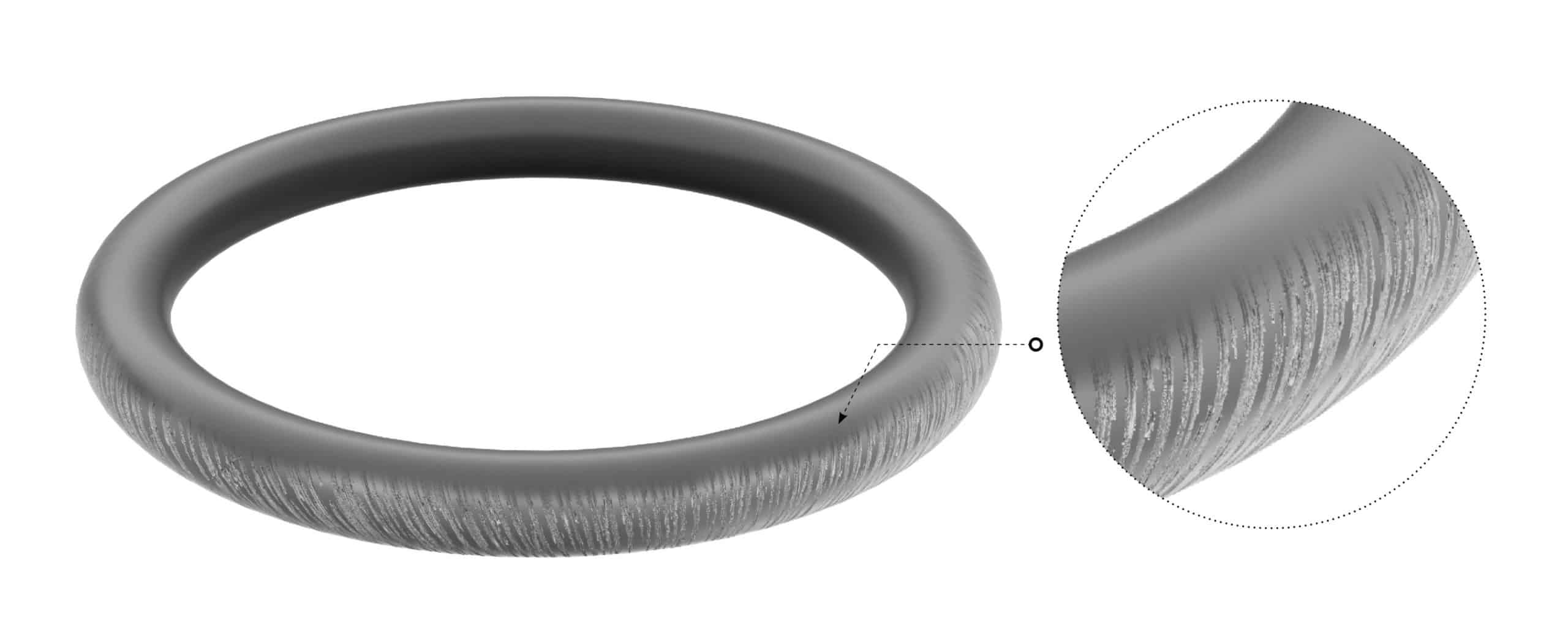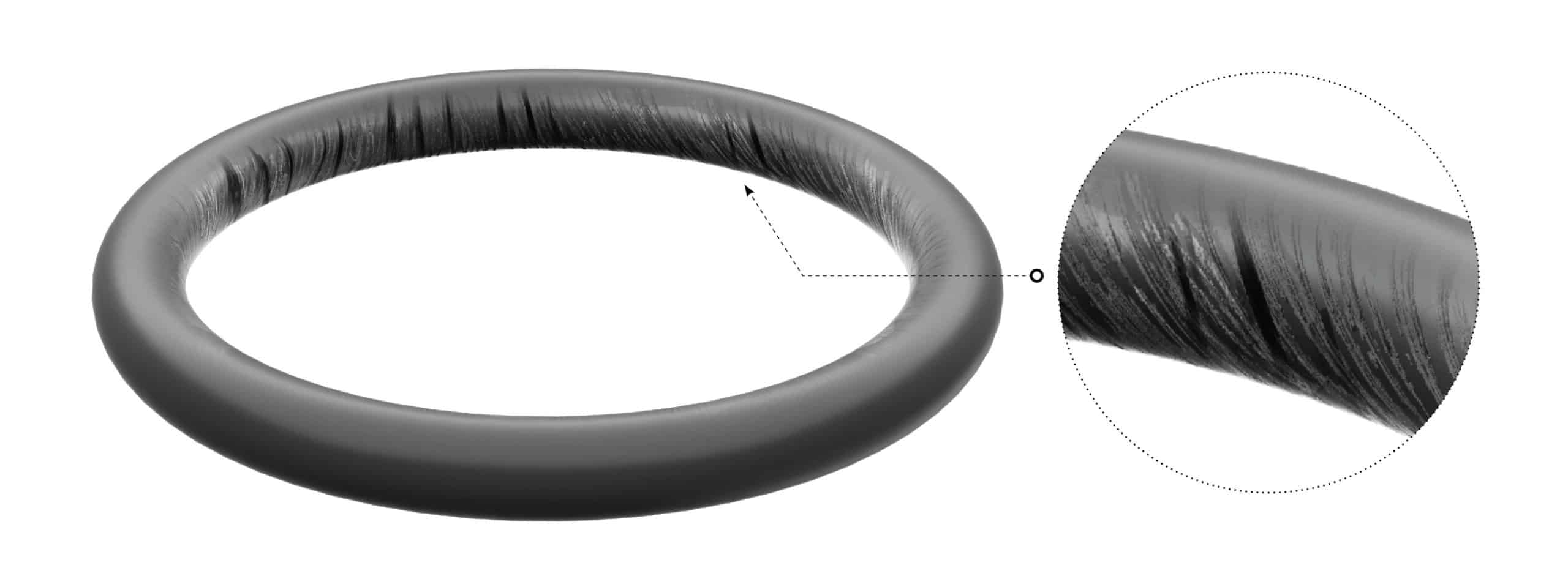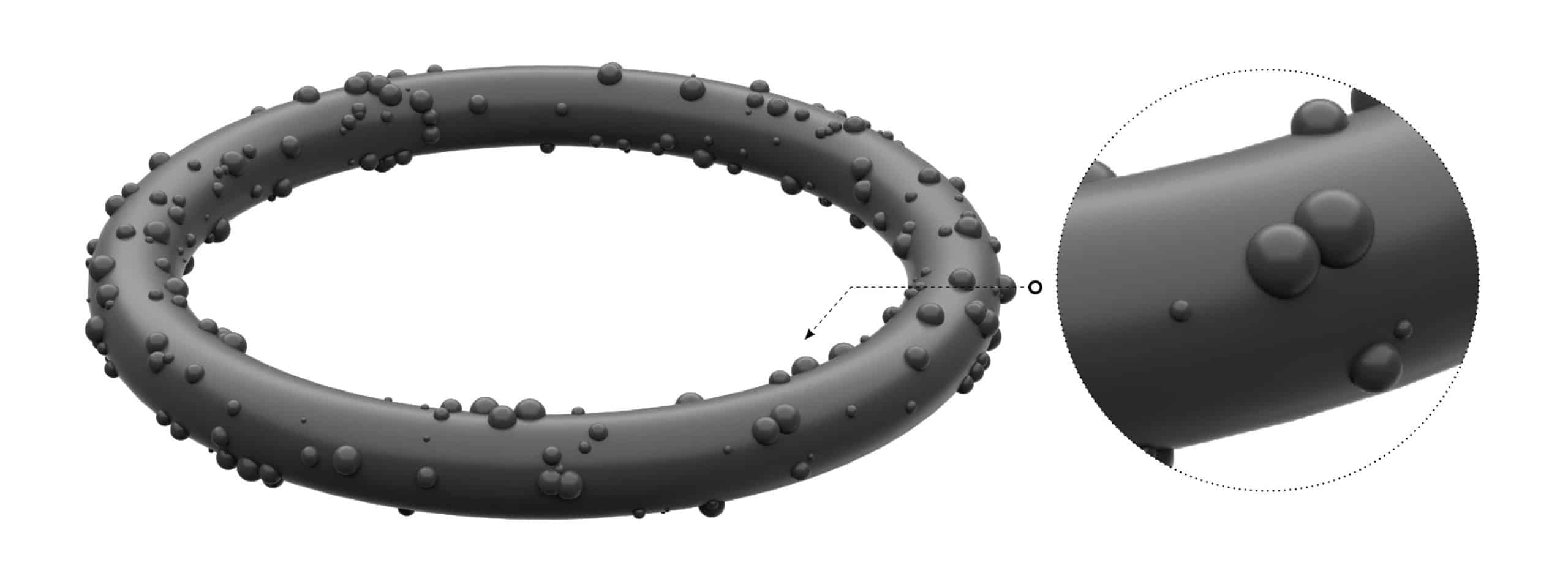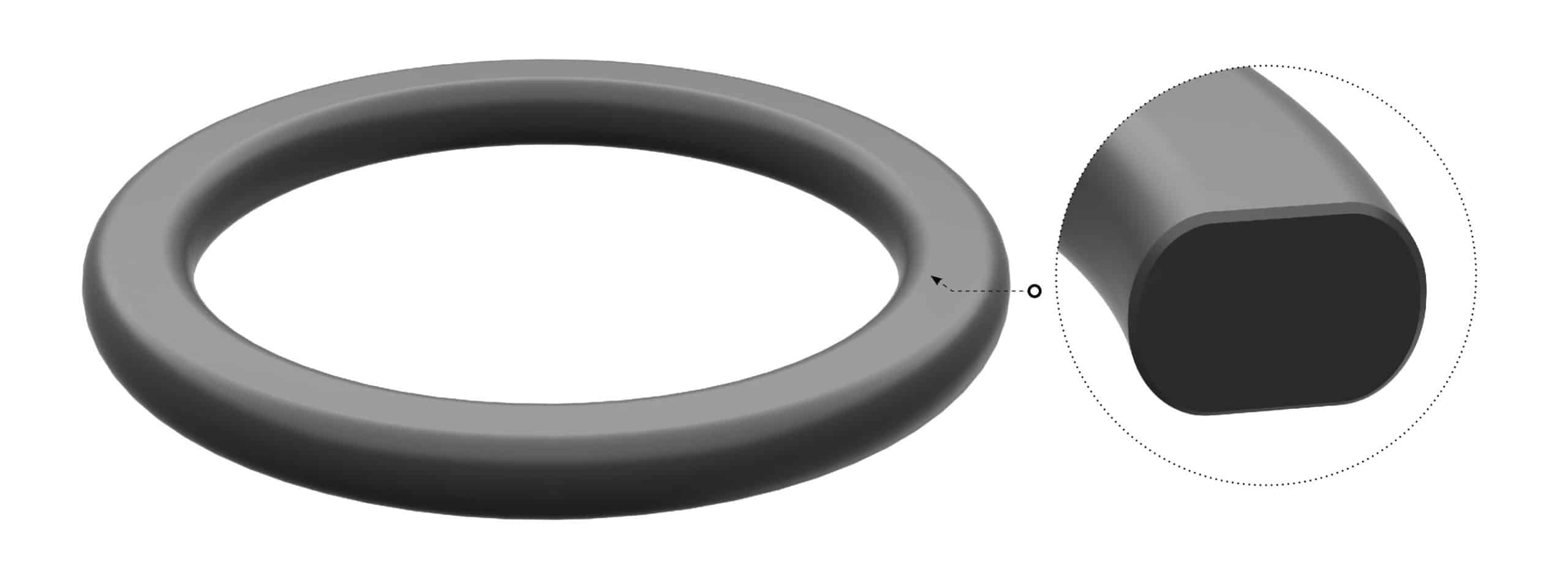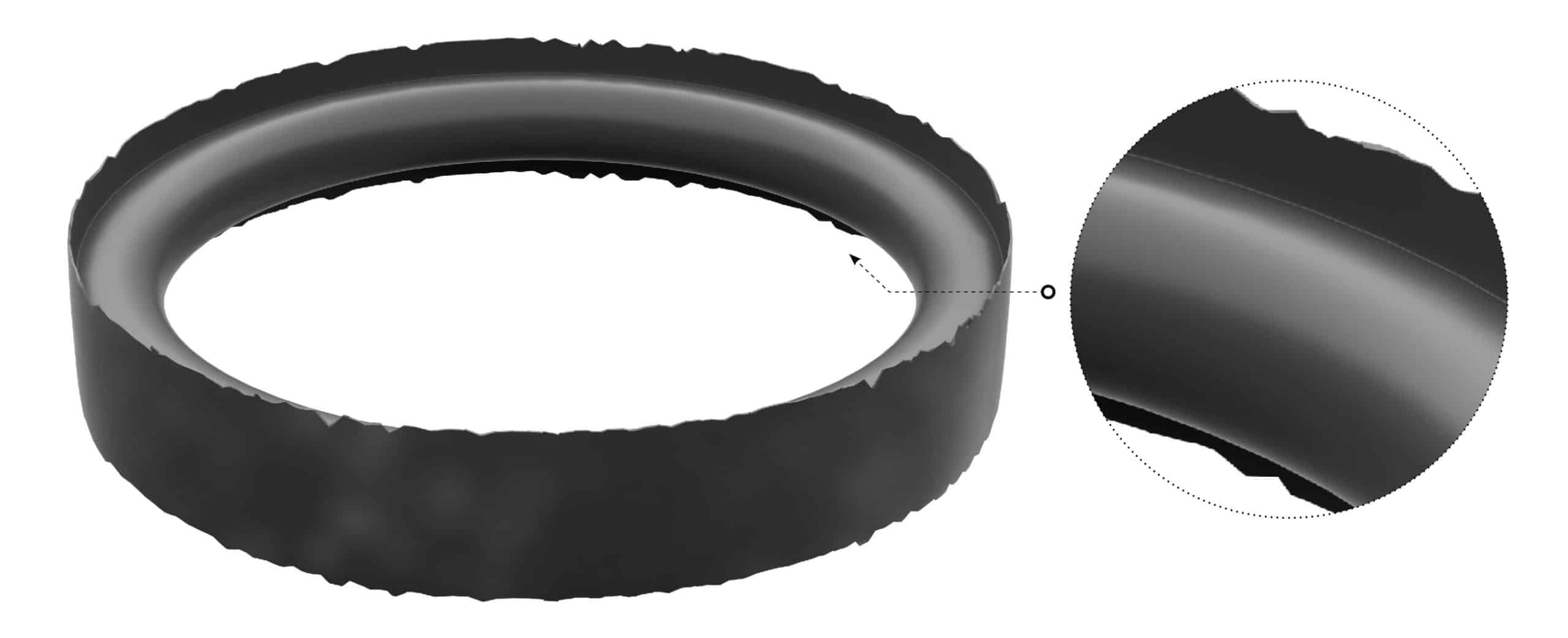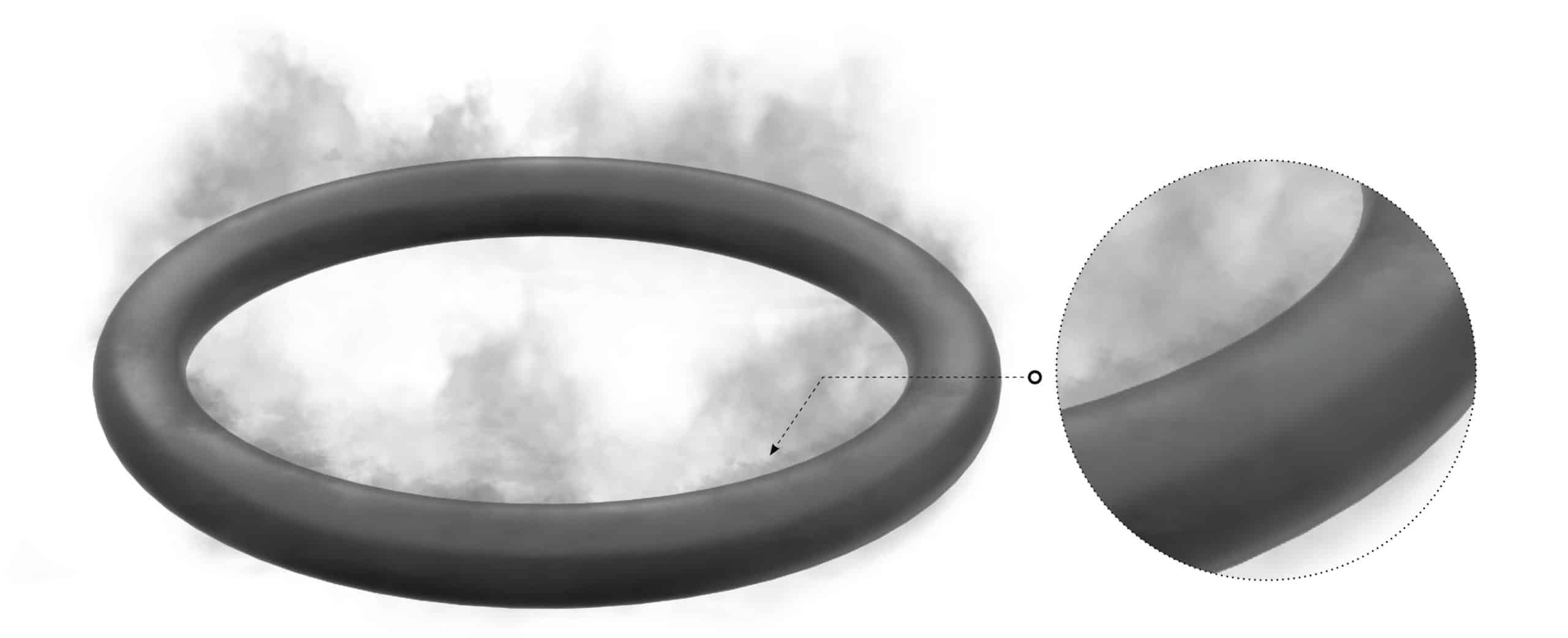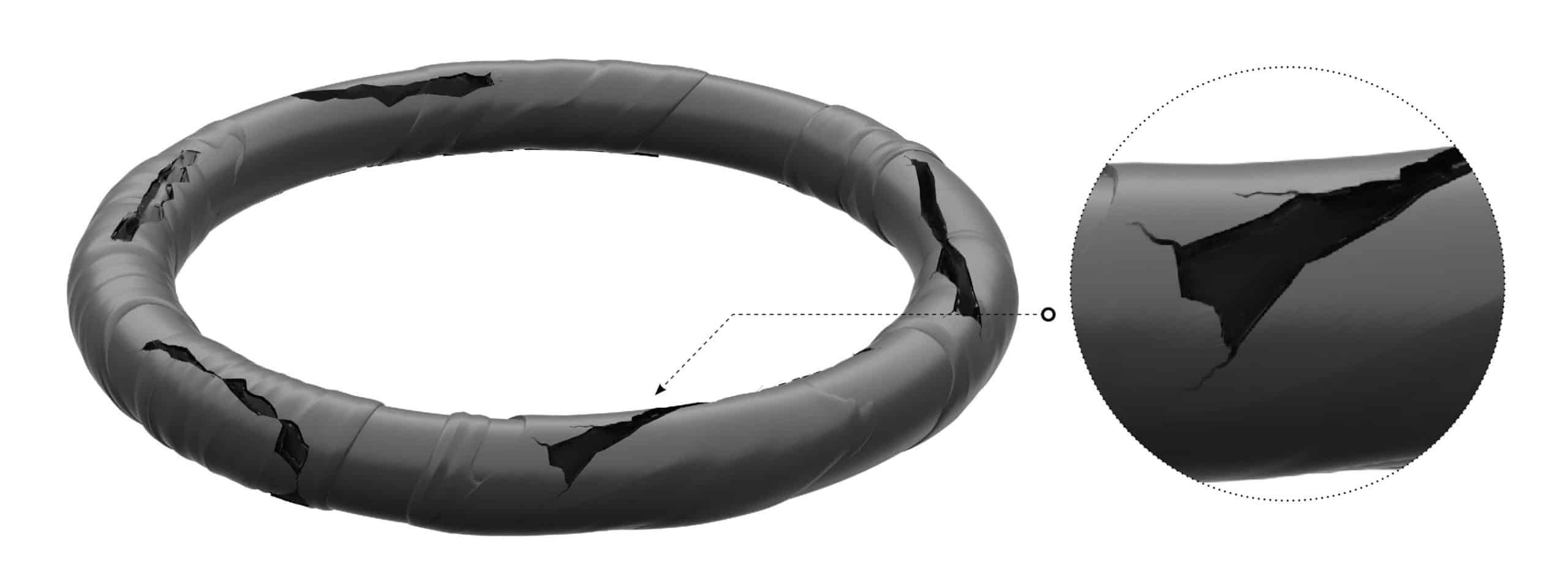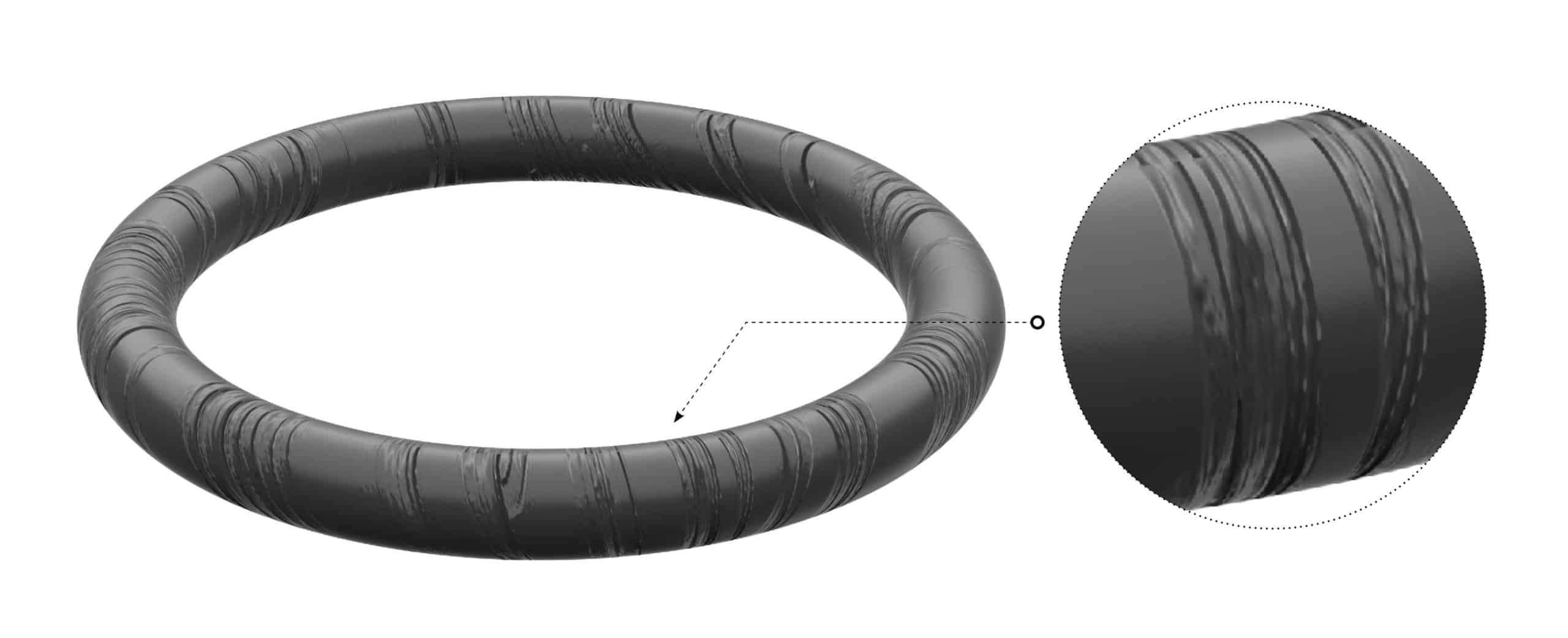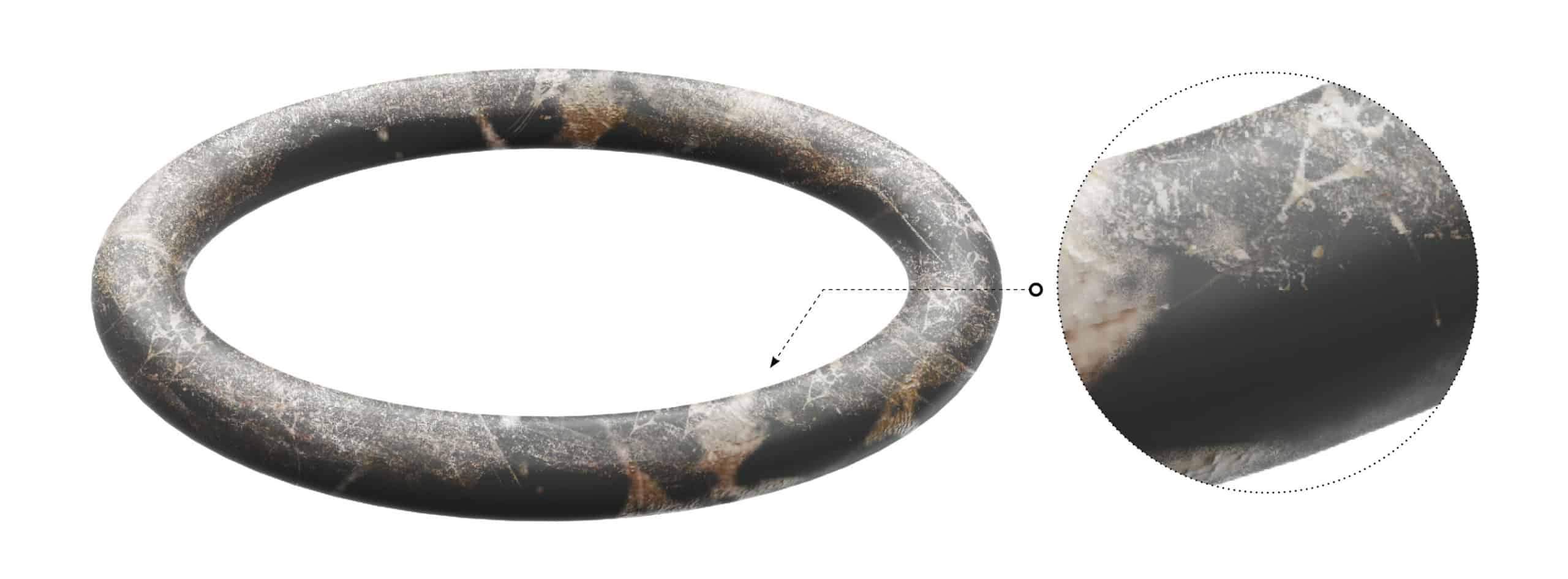ओ-रिंग विफलता के प्रकार
एक ओ-रिंग विभिन्न कारणों से विफल हो सकती है, चाहे वह एक अनुचित यौगिक चयन हो या ओ-रिंग ग्रूव डिज़ाइन के साथ असंगति हो। एक असफल ओ-रिंग का विश्लेषण करके और कारण को अलग करके, कोई भी इस्तेमाल किए गए ओ-रिंग के प्रकार में समायोजन कर सकता है और/या सीलिंग विफलता को रोकने के लिए उपकरण डिजाइन में सुधार कर सकता है। नीचे, हम असफल ओ-रिंगों पर सबसे अधिक देखी जाने वाली चीज़ों को तोड़ते हैं, इन ओ-रिंगों के विफल होने का क्या कारण है, और इस विफलता को एप्लिकेशन में होने से रोकने के लिए कौन से परिवर्तन लागू किए जा सकते हैं। अपने संबंधित अनुभागों पर जाने के लिए निम्न में से किसी भी ओ-रिंग विफलता प्रकार पर क्लिक करें।
Abrasion
What’s Seen: The o-ring has a slightly cropped outer surface. Light scratches may be present with deep cuts and even breaking in some parts of the o-ring.
What Causes It: Dynamic environments are most common in showing abrasion on the o-ring. This is due to constant friction between the housing and the outer surface of the o-ring. A higher risk of abrasion may occur if there is an absence of lubrication on the o-ring when installed.
How To Prevent It: Ensuring the correct lubrication for the sealing system is important, Global O-Ring and Seal supplies O-Lube, Super O-Lube, and O-Ring Grease as a way to improve o-ring resistance to abrasion.
Chemical Degradation
What’s Seen: In relation to chemical exposure within the application, the o-ring may display multiple indicators such as cracks, stains, discoloration, or a difference in hardness.
What Causes It: Specific chemicals interact differently against certain o-ring materials. This may result in a harder material o-ring after use. Alternatively, the o-ring can reduce in hardness and strength which can soften the material and contort the o-ring from its initial form.
How To Prevent It: Selecting the correct o-ring material is crucial to ensure the seal can demonstrate resistance to chemicals within the application. Chemical degradation happens faster when temperatures are higher in conjunction with the o-ring being under excessive pressure. Using the Chemical Compatibility Interactive Tool, multiple chemicals can be selected to instantly display recommended o-ring materials.
Chemical Swelling
What’s Seen: Swelling and bubbling can either be seen throughout the entire o-ring or only in specific areas impacted by chemicals. That being stated, the o-ring may look bigger than its original form.
What Causes It: Chemical swelling in an o-ring happens when chemicals permeate through the seal. The increased seal volume can compromise the strength and sealing function of the o-ring.
How To Prevent It: Use a different o-ring material that is recommended for its resistance against the specific chemicals within the application. Using the Chemical Compatibility Interactive Tool, multiple chemicals can be selected to instantly display recommended o-ring materials.
Compression Set
What’s Seen: The surfaces of the o-ring cross-section have been leveled to conform to the groove. At this point, the o-ring cannot return to its circular cross-sectional shape.
What Causes It: At high temperatures, the o-ring elasticity can reduce and fail to return to its initial form. Stress, coupled with high temperatures, within the application can alter the cross-section shape from circular to more of a flat oval. Another cause is the o-ring groove being too tight.
How To Prevent It: Increasing to a higher durometer o-ring with a higher operating temperature can aid in preserving the function of the o-ring. The o-ring groove design should also be checked to ensure too much squeeze is not being applied to the o-ring. Additionally, implementing backup rings into your application can decrease the probability of the o-ring being pressed into that permanent oval shape.
Damage from Installation
What’s Seen: Precise notches on the outer edge of the o-ring surface caused by improper installation.
What Causes It: The o-ring has not been lubricated properly and/or has been installed in an application with sharp edges. Additionally, if the o-ring is too big or small to fit in its designated groove, this can cause skiving during installation.
How To Prevent It: Taping over edges can help avoid notching during installation. Also, Global O-Ring and Seal supplies sizing and lubrication accessories for o-rings to ensure the right size o-ring is put in place the right way to evade early installation damage.
Extrusion and Nibbling
What’s Seen: Nibbled or ruffled edges can be observed on the side of the o-ring receiving lower pressures.
What Causes It: The o-ring is pushed into a clearance gap in the event of high pressures. Pressure surges can bring about the opening and closing of the clearance gap. This pinches the o-ring within the mating surface edges, which causes the low-pressure end of the o-ring to extrude and appear ruffled when removed from the application.
How To Prevent It: Utilizing o-rings of a higher durometer is recommended. If using 70 durometer o-rings, consider increasing to 90 durometer (widely available in Nitrile and Viton®). Additionally, implementing backup rings into your application can decrease the probability of the o-ring being extruded through clearance gaps.
Outgassing
What’s Seen: In typical situations, the o-ring shows no observable difference. A slight reduction in size can be seen on rare occasions.
What Causes It: In a vacuum environment, molecules making up the o-ring are vaporized. This may impact vacuum effectiveness, as well as contaminate the environment.
How To Prevent It: It is important to verify which o-ring material is appropriate for the application. Check o-ring compound datasheets to evaluate temperature ranges and preferred environments for use for different materials. Certain elastomers are produced to prevent outgassing including Genuine Viton®, Silicone, PTFE, and FFKM.
Rapid Gas Decompression
What’s Seen: Cracks, blisters, and deep cuts may show throughout the o-ring surface. In the worst cases, o-rings are blown out entirely.
What Causes It: When o-rings are subjected to gas at high pressures and temperatures for an extended amount of time, the gas is taken in and contained within the elastomer. Once there is a quick decrease in pressure, the gas rushes out of the o-ring material to cause cracks and blisters.
How To Prevent It: It is recommended to utilize Rapid Gas Decompression (RGD) o-rings, which are available in Viton® 90 and 95 durometer.
Spiral Failure
What’s Seen: Deep, diagonal cuts show around the outer surface of the o-ring.
What Causes It: Twisting within a dynamic application and even as early as installation can cause spiraling marks on the o-ring. Within the dynamic application, spiraling can occur with high friction, absence of o-ring lubrication, or inconsistent surface.
How To Prevent It: Moving to a higher durometer o-ring can help avoid twisting within the application. An alternate solution is using x-rings (also known as quad rings), which are made to double the sealing surface and prevent spiral failure.
Thermal Degradation
What’s Seen: Rounded cracks along the o-ring surface.
What Causes It: The temperature within the environment has surpassed the temperature range of the o-ring. Higher heat can elevate hardness and reduce elasticity, thus causing visible cracks in the stiffened elastomer.
How To Prevent It: Verify the temperature range of the o-ring compound before use within the application. Evaluate spec sheets for o-ring compounds to confirm temperature ranges for different materials, as well as preferred and non-preferred environments for use.
Thermal Extrusion
What’s Seen: Nibbled or ruffled edges can be observed on the o-ring surface. If also in a high-pressure environment, extrusion may show prevalence on the side of the o-ring receiving lower pressure.
What Causes It: Higher temperatures (than what the o-ring is designed to withstand) can cause the o-ring to extrude and fill into clearance gaps.
How To Prevent It: The o-ring groove design should also be evaluated to ensure too much squeeze is not being applied to the o-ring, especially when higher temperatures can extrude material to fill the gland. Check o-ring compound spec sheets and evaluate temperature ranges of different materials, as well as preferred and non-preferred environments for use.
UV Degradation
What’s Seen: Splotches of discoloration along the o-ring surface. In some instances, cracking and breaking with prolonged exposure.
What Causes It: UV light carries high energy within its short wavelengths, which can manipulate the composition of the o-ring. Prolonged exposure can have a damaging impact, which can result in seal leakage.
How To Prevent It: EPDM o-rings and Viton® o-rings in black are recommended for resistance to UV light.
Need Additional Help?
To crosscheck the best o-ring compounds against thousands of chemicals, check out the Chemical Compatibility Interactive Tool. To view our library of o-ring material spec sheets, visit the Compounds Page. To see guidelines for developing an o-ring groove, see the O-Ring Groove Design Page. To browse tools utilized in o-ring sizing and installation, click to the Accessories Page. For any additional information or to request a quote, please submit a form on our Contact Us Page, or call our Sales Team directly at 832-448-5550.

 हिन्दी
हिन्दी  English
English  Español
Español  Français
Français  Português
Português  Deutsch
Deutsch  Italiano
Italiano  Русский
Русский  中文
中文  日本語
日本語  العربية
العربية 